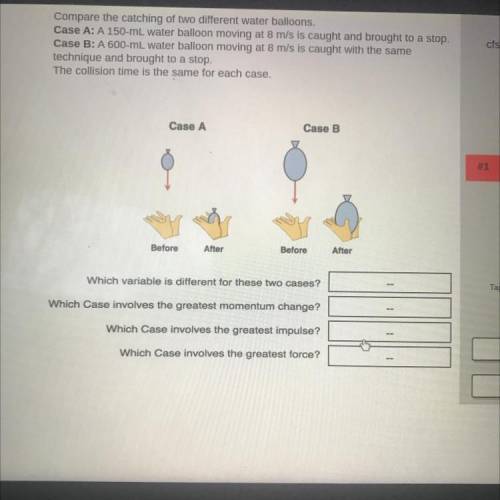
Physics, 17.12.2020 01:00 darenl2163
Compare the catching of two different water balloons
Case A: A 150 ml water balloon moving at me is caught and brought to a stop
Case B: A 600 ml water balloon moving at mis is caught with the same
technique and brought to a stop
The collision time is the same for each case,
Case A
Case B
Before
After
Before
After
Which variable is different for these two cases?
Which Case involves the greatest momentum change?
Which Case involves the greatest impulse?
Which Case involves the greatest force?


Answers: 1


Another question on Physics

Physics, 22.06.2019 15:30
To understand the behavior of the electric field at the surface of a conductor, and its relationship to surface charge on the conductor. a conductor is placed in an external electrostatic field. the external field is uniform before the conductor is placed within it. the conductor is completely isolated from any source of current or charge. part a: which of the following describes the electric field inside this conductor? it is in the same direction as the original external field.it is in the opposite direction from that of the original external field.it has a direction determined entirely by the charge on its surface.it is always zero. part b: the charge density inside the conductor is: 0non-zero; but uniformnon-zero; non-uniforminfinite part c: assume that at some point just outside the surface of the conductor, the electric field has magnitude e and is directed toward the surface of the conductor. what is the charge density η on the surface of the conductor at that point? express your answer in terms of e and ϵ0
Answers: 1

Physics, 22.06.2019 16:30
Acalorimeter uses the principle that thermal energy flows from hotter material to colder material until both reach the same
Answers: 1

Physics, 22.06.2019 16:40
Beryl states that insulation with the smallest possible thermal conductivity is best to keep a house warm in winter, but worst for keeping a house cool in summer. sapphire insists the reverse is true: low thermal conductivity is good in the summer, but bad in the winter. which one, if either is correct? a. beryl, because low thermal conductivity results in low heat transfer. b. beryl, because low thermal conductivity results in high heat transfer. d. sapphire, because low thermal conductivity results in high heat transfer. e. neither, because low heat transfer is desirable both in summer and in winter.
Answers: 2

Physics, 22.06.2019 20:50
An ideal otto cycle has a compression ratio of 8. at the beginning of the compression process, air is at 95 kpa and 27°c, and 750 kj/kg of heat is transferred to air during the constant-volume heat-addition process. assuming constant specific heats at room temperature, determine (a) the pressure and temperature at the end of the heat-addition process, (b) the net work output, (c) the thermal efficiency, and (d) the mean effective pressure for the cycle. (4390 kpa, 1730 k; 423 kj/kg; 56.4%; 534 kpa)
Answers: 1
You know the right answer?
Compare the catching of two different water balloons
Case A: A 150 ml water balloon moving at me is...
Questions

Mathematics, 28.01.2021 09:10


Mathematics, 28.01.2021 09:10




Mathematics, 28.01.2021 09:10


Spanish, 28.01.2021 09:10




Mathematics, 28.01.2021 09:10


Mathematics, 28.01.2021 09:10

Geography, 28.01.2021 09:10

Mathematics, 28.01.2021 09:10

Social Studies, 28.01.2021 09:10


History, 28.01.2021 09:10



